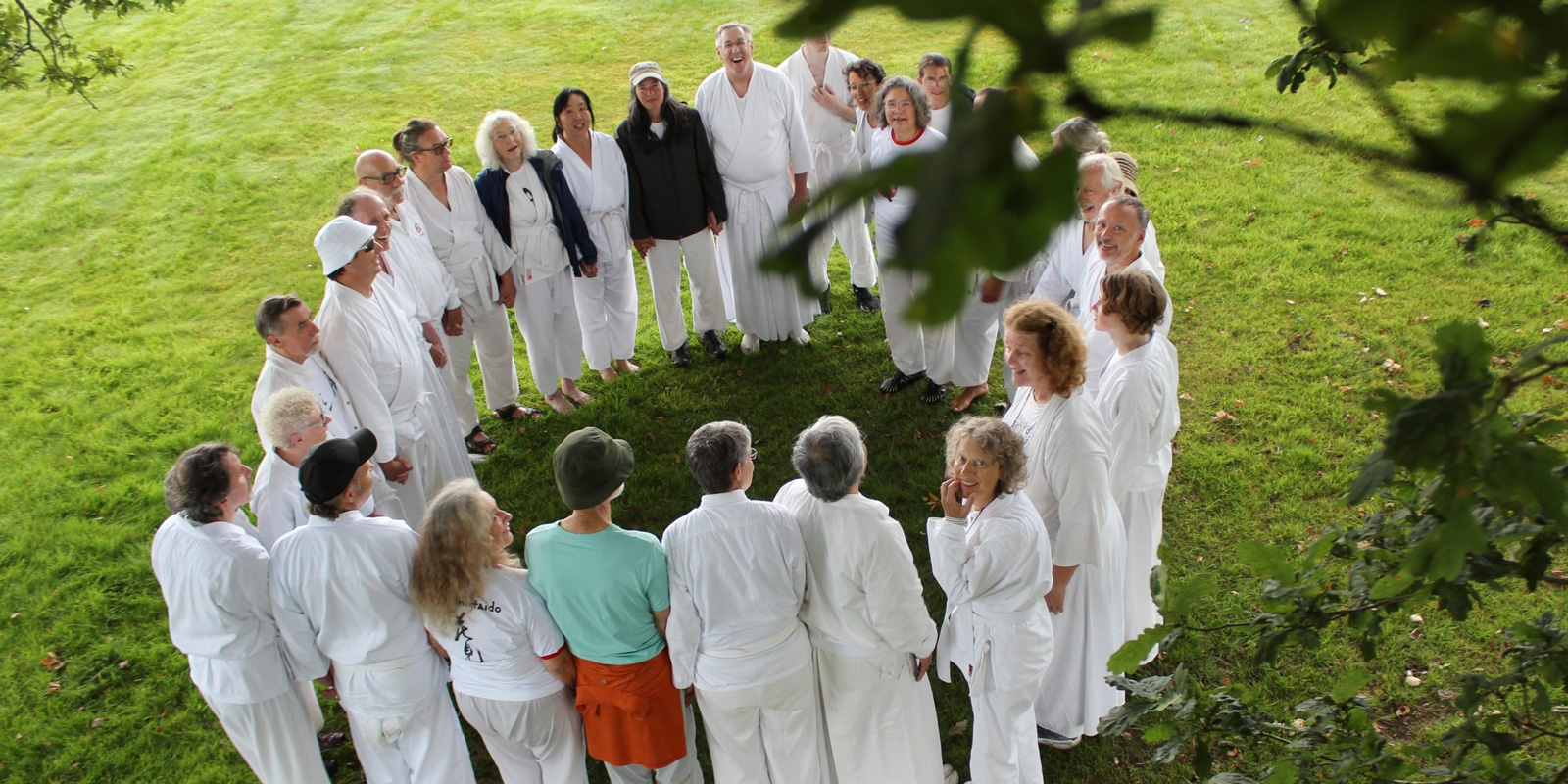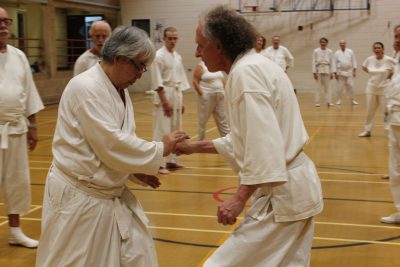

This event at Worth Abbey School, led by Masashi Minagawa and managed by Charles Burns with the assistance of Viola Santa, represented new life in many respects. In addition to the keiko itself (of which, more below), it was our first visit to Worth Abbey School; it brought five members of ITEC to our daienshu for the first time alongside some totally new practitioners so we had 33 practitioners, almost double our usual number; that meant it didn’t feel like one of our usual, slightly introverted BS events, but – as indeed it was intended to be – an embryonic version of the much more expansive International which we will be hosting on the same site in 2024.
Worth is easy-access for international visitors coming by plane to Gatwick or train to Crawley. The site is vast, green, orderly and peaceful, with wonderful outdoor dojos and fabulous spaces for morning Taimyo; a large sportshall (though its floor is alarmingly unforgiving); comfortable single rooms (despite some grumbles about the mattresses – to go with others the lack of single-sex washroom facilities and spartan showers); a lovely neo-Jacobean panelled meeting room; and a huge dining room where we were offered huge school-food portions supplemented by a salad bar. The communal facilities in the accommodation bloc were more than adequate – altogether to most members it felt like a good site, and with a little tweaking will surely work well for the International.
Following the pre-gasshuku BSC keiko in the field, the opening meeting was rounded off with a long, low, resonant blast on a huge conch from Jackie. This was followed by the first keiko in the sportshall, with many variations of Ma exercises and Tenshingoso; there were many changes of partner that brought us all close together. No-one wanted to leave at the end of the keiko: those planning their exams took the opportunity for revision, while many others spontaneously found kumite partners and the dojo continued to rock for hours.
Early next morning, we slowly explored Taimyo Part III beneath two large oak trees and looking down over the golf course, in the morning sunshine and with a flock of swallows darting around us. The second keiko began with some vigorous tsuki and Eiko, before moving onto kumite, receiving tsuki attack with Tenshingoso applications, and receiving jodan attack with mai irimi and yoko irimi. Building on yesterday’s Ma exercises, Masashi stressed the importance of settling or grounding as you receive the attack, and before sending the partner on their way.
The afternoon session was entirely taken up with exams – which ranged from 9/10 kyu boh and karate exams, to nidan bohjutsu and kenjutsu. The entire session was very impressive, the examinees were all seriously committed, and the nidan kumite, in particular, both skilful and spectacular. Watching was a great opportunity for the newer members to see what their practice might lead to one day, and for older members to revisit their prejudices about exams.
In the evening, after the exam results were announced, we held a social in the communal area, led by Carina. It included a gong bath from Jackie, after which Masashi explored the possibilities of sonic calligraphy, tracing the characters Do-gen (way of the circle – the theme of next year’s International) on the gong. This was followed by singing, and chatting around the firepit, till late.
Early Sunday morning was just as bright, but somewhat dewier, than Saturday, as Ula led us in Diamond Eight Cutting under the trees. But by the time the final keiko began, in the outdoor dojo, dark clouds had appeared and the keiko was interrupted with short showers that made us move under the trees. The extensive kumite – wakame, more Tenshingoso applications – built on the previous two keiko, before we picked up our bokken and practised kyukajo.
 Building on all this, the keiko finished with a rare treat – genuinely spectacular and moving demonstrations by the ITEC members of key features of the keiko (and incorporating some exam feedback): Gianni Rossi showing tsuki, Tenshingoso and boh kata; Charles Burns and Rob Gaston showing neriai; Ula Chambers and Connie Borden kyukajo; and finally David Franklin and Gianni Rossi doing a typically free and powerful kiri oroshi kumite. Everyone watching knew that they’d seen something very special, and had been given a unique gift, an intimate vision of what Shintaido can really be in the hands of committed practitioners.
Building on all this, the keiko finished with a rare treat – genuinely spectacular and moving demonstrations by the ITEC members of key features of the keiko (and incorporating some exam feedback): Gianni Rossi showing tsuki, Tenshingoso and boh kata; Charles Burns and Rob Gaston showing neriai; Ula Chambers and Connie Borden kyukajo; and finally David Franklin and Gianni Rossi doing a typically free and powerful kiri oroshi kumite. Everyone watching knew that they’d seen something very special, and had been given a unique gift, an intimate vision of what Shintaido can really be in the hands of committed practitioners.
The closing meeting was typically emotional and beautiful, with a palpable sense of new life in many forms. One person spoke of a sense that the trees having grown higher, and their roots deeper, over the course of the gasshuku; another being inspired by Masashi to do things they never thought possible; another described how the exams showed that if you really decide to do something, you can achieve beyond your own expectations. The theme of Do-gen was also mentioned, with its idea of an endless circle of Shintaido and of teaching, where we can all enter and leave the circle at any point, while it keeps on turning through everyone’s efforts, and with every individual contributing to that.
We all agreed that next year’s International had already begun. I’m sure everyone will be back.
